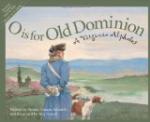Now, a glimpse could be had of a relic of old James Towne, the ruined church tower, deep-set among the trees. Could our eyes have pierced the water under us, we might have seen more of the ruins of the ancient village. For Gadabout was holding in quite close to shore where no vessel could have gone in James Towne days, as the place was then solid land and a part of the settlement. Now, that part lay buried at the bottom of the river, and our boat was passing over it.
Coasting around the end of the island, we came upon a tree standing out in the water a hundred yards from shore. It was the famous “Lone Cypress,” once growing on the island, now spreading its green branches in the midst of a watery waste—silently attesting the sacrifice of historic soil to the greedy river. A little way beyond the tree was what we were seeking, the upper entrance into the waterway behind the island.
[Illustration: Wharf sign at Jamestown island.]
[Illustration: The “Lone cypress.”]
In the days of the old settlement, there was no such entrance at this end; for here the narrow isthmus extended across, connecting with the mainland. But the same resistless wash of waves that had carried part of James Towne into the bed of the river, had broken down and submerged the isthmus too; and our chart showed that there was water enough for our houseboat to sail over where the colonists used to walk dry-shod.
As to the obstruction we had seen indicated on the chart, that proved to be the ruins of an old bridge extending out from the mainland along the submerged isthmus. But the island end of it had been carried away, and we readily passed through the opening left and got again into Back River behind the island. Following this for a few hundred yards, we found ourselves at last beside the bridge we long had sought. Standing on the upper deck, we could look down stream to the place where our houseboat had been stopped by the row of pilings. We had practically circumnavigated the island.
While making Gadabout fast to some convenient pilings, we heard gay voices and the rumble of wheels on the bridge.
“Look! Look!” cried one of a carriage-full of hatless girls in white muslins. “There’s a houseboat. How in the world did it get in here?”
And we rather wondered ourselves.
CHAPTER V
FANCIES AFLOAT AND RUINS ASHORE
It was midday when we tied Gadabout to the pilings beside the bridge, and the weather was hot and sultry. So, we deferred until evening the long walk across the island. But already, sitting under our own awning, we were in the thick of historic association.
Where our houseboat lay, the early colonists used to find haven for their vessels, “lashed to one another and moor’d a shore secure from all Wind and Weather Whatsoever.” As they found Back River at this point so we found it, a stream without banks; instead, on either hand stretched lonely marshes, jungles of reeds and rushes, now as then more than man high.




